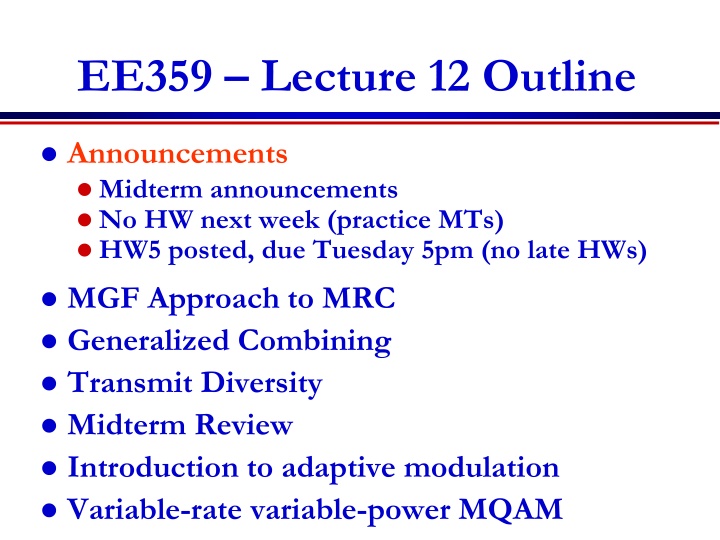
Advanced Techniques in Wireless Communication
Explore the topics covered in Lecture 12, focusing on Generalized Combining, Transmit Diversity, and Adaptive Modulation in wireless communication systems. Get insights into midterm announcements, review sessions, and key concepts such as Selection Combining and Maximal Ratio Combining. Dive deep into performance metrics, diversity gains, and the MGF approach for analyzing system performance. Prepare for the upcoming midterm with available resources and practice exams.
Download Presentation

Please find below an Image/Link to download the presentation.
The content on the website is provided AS IS for your information and personal use only. It may not be sold, licensed, or shared on other websites without obtaining consent from the author. If you encounter any issues during the download, it is possible that the publisher has removed the file from their server.
You are allowed to download the files provided on this website for personal or commercial use, subject to the condition that they are used lawfully. All files are the property of their respective owners.
The content on the website is provided AS IS for your information and personal use only. It may not be sold, licensed, or shared on other websites without obtaining consent from the author.
E N D
Presentation Transcript
EE359 Lecture 12 Outline Announcements Midterm announcements No HW next week (practice MTs) HW5 posted, due Tuesday 5pm (no late HWs) MGF Approach to MRC Generalized Combining Transmit Diversity Midterm Review Introduction to adaptive modulation Variable-rate variable-power MQAM
Midterm Announcements Midterm: Friday (2/21), 2-4 pm in (Hewlett 103) Food will be served after the exam! Review sessions My midterm review will be during today s lecture TA review (+OHs): Wednesday 2/19 from 4-6 pm in 364 Packard Midterm logistics: Open book/notes; Bring reader/calculators. Disconnected electronic devices OK. Covers Chapters 1-7 (sections covered in lecture and/or HW) OHs next week: Me: Tue 2/18: 3-4:45pm, Thu 6-7pm, Fri 10:30-11:30am all in 371 Packard Tom: Wed ~5-6pm, Thu 1:30-2:50pm, Fri 11:30-12:30pm No HW next week Midterms from past 3 MTs posted: 10 bonus points for taking a practice exam Solutions for all exams given when you turn in practice exam
Review of Last Lecture Array Structure of a Diversity Combiner Performance metrics: Outage probability and average probability of error Array and Diversity gain Combining Techniques Selection Combining (SC): Path with highest gain used Maximal Ratio Combining (MRC): Paths cophased and summed with optimal weights to maximize SNR SC Performance Analysis Combiner SNR is the maximum of the branch SNRs. CDF easy to obtain ( ip( i< thr)),pdf found by differentiating. Poutobtained from CDF. Average Pstypically found numerically Diminishing returns with number of antennas. Can get up to about 20 dB of gain.
Review continued MRC and its Performance With MRC, = ifor branch SNRs i Optimal technique to maximize output SNR Yields 20-40 dB performance gains Distribution of hard to obtain Standard average BER calculation = ( ( = ( ( ( ( P P p d P p p p d d d ) ) ... ) ) ) ... ) ... * * * b b b M M 1 2 1 2 Hard to obtain in closed form Integral often diverges MGF Approach: For Psin AWGN of
Generalized Combining For a diversity system with M branches: Selects L branches, 1<L<M, with the highest SNR Combined the L branches with MRC or EGC Complexity/performance tradeoffs Better performance than L-branch MRC/EGC with higher complexity Worse performance than M-branch MRC/EGC with lower complexity Performance analysis requires order statistics to characterize the L branches with the best SNR MGF approach with order statistics can be used to obtain the distribution of the output SNR, Ps, Pout
Transmit Diversity Not covered in lecture/HW/exams With channel knowledge, similar to receiver diversity, same array/diversity gain Without channel knowledge, can obtain diversity gain through Alamouti scheme: 2 TX antenna space-time block code (STBC) Works over 2 consecutive symbols Achieves full diversity gain, no array gain Part of various wireless standards, including LTE Hard to generalize to more than 2 TX antennas Alamouti code not covered in lecture/exams
Midterm Review Overview of Wireless Systems Signal Propagation and Channel Models Modulation and Performance Metrics Impact of Channel on Performance Fundamental Capacity Limits Diversity Techniques Main Points
Adaptive Modulation (not on MT) Change modulation relative to fading Parameters to adapt: Constellation size Transmit power Instantaneous BER Symbol time Coding rate/scheme Only 1-2 degrees of freedom needed for good performance Optimization criterion: Maximize throughput Minimize average power Minimize average BER
Variable-Rate Variable-Power MQAM One of the M( ) Points log2 M( ) Bits To Channel M( )-QAM Modulator Power: P( ) Point Selector Uncoded Data Bits Delay (t) (t) 16-QAM 4-QAM BSPK Goal: Optimize P( ) and M( ) to maximize R=Elog[M( )] subject to error probability target: Problem formulation and solution similar to flat-fading capacity
Main Points Analysis of MRC simplified using MGF approach GC combines benefits of SC and MRC TX diversity with CSI at TX same as RX diversity Can obtain diversity gain even without channel information at transmitter via space-time block codes. Adaptive modulation leverages fast fading to improve performance (throughput, BER, etc.) Adaptive MQAM adapts instantaneous power and data rate to maximize average data rate Optimization very similar to flat-fading channel capacity
